
 Home Home |
 For authors For authors |
 Submission status Submission status |
 Current Current
|
 Archive Archive
|
 Archive
(English) Archive
(English)
|
 Search Search |
Mesocavities support simultaneous interactions of exciton to few cavity modes. Such situation occurs when strength of exciton-photon interaction (Rabi splitting) and energy interval between cavity modes are comparable. Recently, non-monotonic dependence of the occupancy of polariton states on the pumping intensity has been observed.
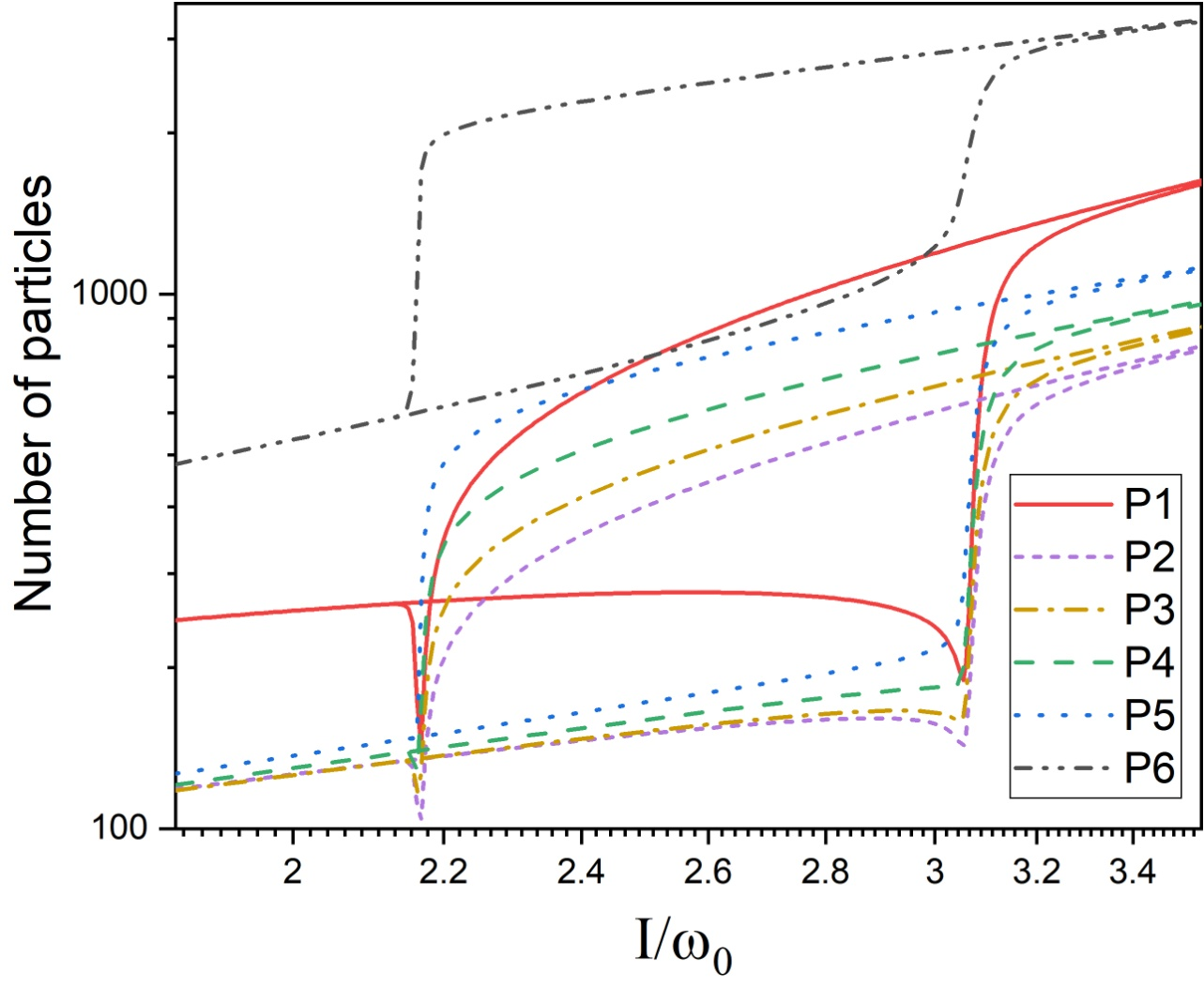
Figure. Dependence of the population of polariton modes on pumping. For polariton modes with energies below the exciton energy, anomalous hysteresis loops are observed with a nonmonotonic dependence of the population on pumping.
A. V. Belonovskii, V. V. Nikolaev, E. I. Girshova
JETP Letters 117, issue 2 (2023)
The Fröhlich charge transfer mode was initially erroneously proposed as an explanation for superconductivity. It turned out later that the described collective conductivity mechanism is indeed realized in quasi-one-dimensional conductors with charge density waves (CDWs), but the CDW conductivity is finite. Moreover, in the limit of a strong electric field E, the CDW conductivity, $\sigma_{\rm CDW}(\it E)$, approaches the conductivity of the electrons condensed in it in the normal (metallic) state, but never exceeds it. No universal explanation for this regularity has been proposed by now.
In this work, this regularity is probed on the NbS3 monoclinic phase. NbS3 compound is unique in that three CDWs are formed in it, and all three can slide in the presence of electric field. The authors have suggested a way of mobility estimation, applicable both to the CDWs and to the quasiparticles forming them. It turned out that the difference between the mobilities of different CDWs reaches almost two orders of magnitude. At the same time, the mobility of each of them is close to the normal-state mobility of the quasiparticles forming it. Moreover, there is a correlation between the temperature dependences of CDW and quasiparticle mobilities. For example, both the CDW-0 state and its constituent quasiparticles exhibit a dielectric behavior. In this case, the mobility value, 0.04–0.05 cm2/Vs, evidences for the hopping origin of conduction. The results of the work actualize questions about the mechanism of limiting conductivity of charge density waves.

Fragments of temperature dependences of conductivity of NbS3 samples in the regions of the three CDW transitions: TP0 (left), TP1 (middle) and TP2 (right). The vertical red lines show the “projections” of the $\sigma (\it E)$ dependences measured up to the high fields. The lines are placed at the temperatures, at which $\sigma (\it E)$ was measured. The length of each line gives the estimate of $\sigma_{\rm CDW}(\infty)$. One can see that this value is comparable with the value of s step, $\delta \sigma$, at the corresponding CDW transition (the left panel illustrates the method of $\delta \sigma$ estimation).
S. Zybtsev, V.Ya. Pokrovskii, S. Nikonov, A. Mayzlakh, S. Zaitsev-Zotov
JETP Letters 117, issue 2 (2023)
The neutrino masses are at least six orders of magnitude smaller than the masses of all other charged fermions of the Standard Model. The exchange of weakly interacting particles of low mass creates an interaction potential with a high interaction radius, which can affect the structure of neutron stars. Since neutrinos are fermions, they can participate in long-range two-body interactions through the exchange of neutrino pairs. The neutrino-pair exchange potential is similar to the van der Waals potential resulting from the exchange of two photons.
The infrared instability of long-range multiparticle neutrino interactions in neutron stars has been the subject of discussion for a long time [1-3]. For regularization of neutrino-induced interactions in the infrared range, it was proposed to limit neutrino masses from below to a value of the order of one electron volt, which is remarkably close to the current neutrino mass constraints derived from tritium β-decay experiments and cosmological models.
In this paper, it is demonstrated that the infrared divergences discussed so far in the literature are absent in each individual term of the decomposition of the thermodynamic potential by powers of neutron matter density. Moreover, for both massless and massive neutrinos, all the terms vanish except for the interaction of two neutrons, which is negligible. As a result, long-range multiparticle neutrino interactions have no observable effect on the structure and stability of neutron stars.
[1] E. Fischbach, Long-Range Forces and Neutrino Mass, Ann. Phys. (N.Y.) 247, 213 (1996).
[2] As. Abada, M.B. Gavela, O. Pinea, To rescue a star, Phys. Lett. B 387, 315-319 (1996).
[3] E. Fischbach, D.E. Krause, Quan Le Thien and C. Scarlett, Implications of Recent KATRIN Results for Lower-Limits on Neutrino Masses, arXiv:2208.03790v1 [hep-ph] 7 Aug 2022.
M.I. Krivoruchenko
JETP Letters 117, issue 2 (2023)
The intrinsic antiferromagnetic topological insulator MnBi2Te4 provides a very attractive platform for the realization of various magnetic and topological states. In the ground state, the MnBi2Te4 thin films with an even number of septuple-layer blocks are axion insulators, but with increasing external magnetic field, they show a transition to quantum anomalous Hall regime, which is accompanied by conversion between collinear and non-collinear magnetization textures.
In this letter we present theoretical investigation of such topological transition. In the continuum approach, we model an effective two-dimensional Hamiltonian for the thin film of a topological insulator with non-collinear magnetization, on the basis of which we obtain the energy spectrum and the Berry curvature. The analysis of topological indices makes it possible to construct a topological phase diagram depending on the parameters of the system and the canting angle. For topologically different regions of the diagram, we describe the edge electronic states on the film side face. In addition, we investigate the spectrum of one-dimensional states on the domain wall separating domains with the opposite canting angles (see the figure). We also discuss the experimental situation in the MnBi2Te4 thin films.
The obtained results significantly deepen the understanding of the relationship between band topology and magnetic ordering.
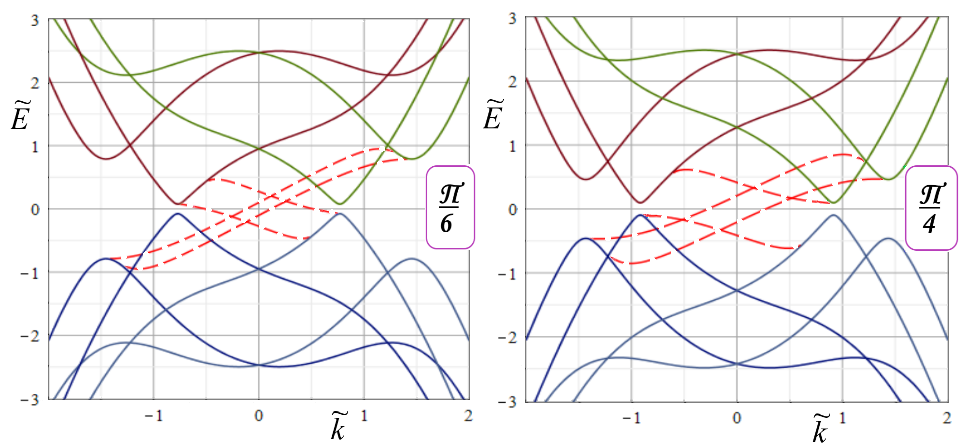
Spectrum of electronic states in a thin film of antiferromagnetic topological insulator containing a domain wall.
V. N. Men’shov & E. V. Chulkov
JETP Letters 117, issue 2 (2023)
Optical coherence tomography (OCT) is a non-invasive imaging approach, expending the diagnostic possibilities in a wide range of tasks. An ability to resolve two closely located reflectors characterizes longitudinal spatial resolution, which is one of the most important characteristics of the OCT system. However, chromatic dispersion of the sample deteriorates the spatial resolution. Quantum OCT, based on the biphoton interferometery (general scheme is shown in figure 1, on the left), is widely considered as a means to cancel the dispersion effect.
The current Letter reports on a novel quantum OCT approach, based on interference of biphotons, that have different frequencies of the photons. It is shown that when the spectral separation between the photons is changed, the probability of coincident detection of the photons has an oscillating shape (an example of a spectral-domain biphoton interference signal is shown in figure 1 on the right).
The proposed spectral-domain quantum OCT approach was compared with traditional time-domain quantum OCT and classical OCT in terms of the longitudinal spatial resolution. It was analytically shown that when both the parasitic interference components and dispersion influence are taken into account, spatial resolutions of both time-domain quantum OCT and classical OCT are nearly the same, while the proposed spectral-domain quantum OCT can provide about 1.5-times better spatial resolution.

N. Ushakov, T. Makovetskaya,.A.Markvart, L.Liokumovich
JETP Letters 117, issue 1 (2023)
Within the self-consistent nuclear many-body theory and the Green function method, the task of calculation probabilities of the E1- transition between the first $2^+ and 3^-$ -excited levels in nuclei with pairing is considered. For the first time, calculations were performed for a long chain of even-even tin isotopes. For the characteristics of both phonons and E1- transitions between excited states, the well-known Fayans energy density functional was used. A good description of the available experimental data has been obtained for the reduced probabilities of E1 transitions between the first one-phonon states for isotopes 116-124Sn, rather than for isotopes 112Sn and 114Sn. Possible causes of this discrepancy are discussed, the most probable of which is the appearance of deformation in the ground or excited states. It is shown that for the explanation of E1-transition experiments in 116−124Sn it is necessary to take into account new (i.e. dynamic three-quasiparticle) ground state correlations (GSC), Fig.1. Therefore, a self-consistent theoretical analysis of transitions between excited states is very promising for low-energy physics.
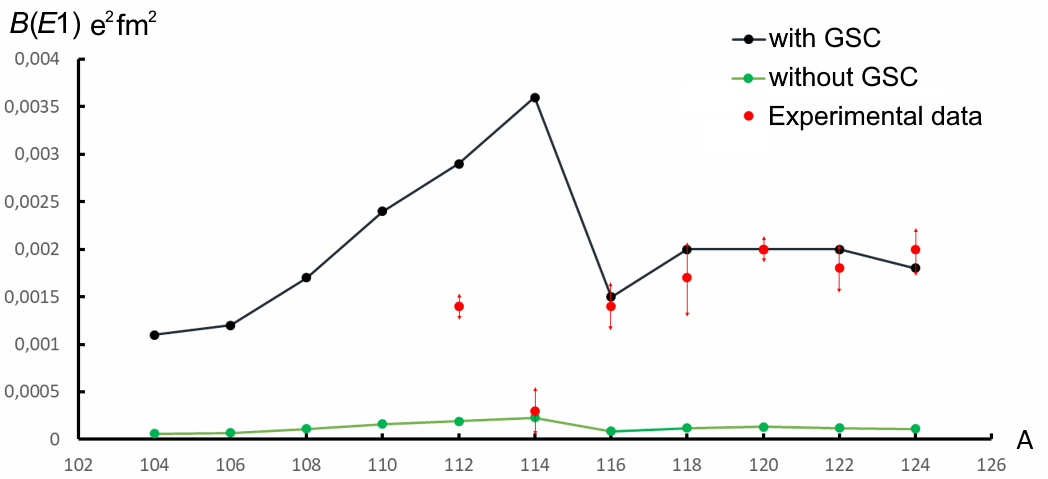
Fig.1. The reduced probabilities of E1-transition between one-phonon states B(E1)($3^-_1 \rightarrow 2^+_1$), e2fm2.
The results of the calculation with and without dynamic ground state correlations are given. Experimental data [1, 2]
[1] R. Wirowski, M. Shimmer, L. Eser, S. Alberos, K.O. Zell and P. von Brentano, Nucl. Phys. A 586, 427 (1995).
[2] L. I. Govor, A. M. Demidov, O. K. Zhuravlev, I. V. Mikhajlov and E. Y. Shkuratova, Sov. J. Nucl. Phys. 54, 196 (1991).
M. I. Shitov, S. P. Kamerdzhiev, S. V. Tolokonnikov
JETP Letters 117, issue 1 (2023)
The Mott (metal-insulator) transition occurs in d-metal compounds owing to strong Coulomb interaction (electron correlations). More often, this transition occurs in antiferromagnetic phase (so-called Slater scenario), but the situation changes for magnetically frustrated systems: only paramagnetic metallic and insulator states are involved, a spin liquid being formed. The transition into such insulator state is related to correlation-induced Hubbard splitting (the Mott scenario). In the Mott state the gap in the spectrum is essentially the charge gap determined by boson excitation branch. Therefore the electrons become fractionalized: the spin degrees of freedoms are determined by neutral fermions (spinons), and charge ones by bosons. The corresponding slave-boson representation was first introduced by Anderson.
In fact, bosons and fermions are coupled by a gauge field, so that the problem of confinement occurs. The transition into the metallic confinement state is described as a Bose condensation, the electron Green's function acquiring finite residue. On the other hand, in the deconfinement insulator state the bosons have a gap, so that the spectrum is incoherent (the full electron Green's function is a convolution of boson and fermion ones) and includes Hubbard's bands.
New theoretical developments provided a topological point of view for the Mott transition, since spin liquid possesses topological order. Phase transitions in frustrated systems can be treated in terms of topological excitations (instantons, monopoles, visons, vortices) which play a crucial role for confinement.
To describe the Mott transition we use the Kotliar-Ruckenstein slave-boson representation which provides explicitly the spectrum of both Hubbard bands. In the absence of considerable quasimomentum dependence of spinon distribution function (a localized spin phase without fermion hopping), the corresponding self-energy tends to zero. However, for a spin liquid we have a sharp Fermi surface. Thus for the Mott insulators the spinon Fermi surface is expected to be preserved even in the insulating phase, so that the Luttinger theorem (conservation of the volume under the Fermi surface) remains valid. However, this Fermi surface is strongly temperature dependent since a characteristic scale of spinon energies is small in comparison with that of electron ones. Thus the spectrum picture in the insulating state is considerably influenced by the spinon spin-liquid spectrum and hidden Fermi surface.
V.Yu Irkhin
JETP Letter 117, issue 1 (2023)
In an imbalanced bilayer electron system formed in a single wide (60 nm) GaAs quantum well, we have observed an unexpected drastic transformation of the sequence of quantum Hall effect (QHE) states when tilting the magnetic field from the normal to the plane of the bilayer system. The collective integer QHE states at total filling $\nu$ one and two are replaced by a set of fractional QHE states. Depending on the total electron density and its distribution between the two layers, controlled by the top- and back-gate voltages, the $\nu_F=4/3$, 6/5, 10/7 and 5/4 fractional quantum Hall states with both odd and even denominators have been observed. They typically come in pairs with two different fractions for a single field sweep. With a dual gate capacitive technique [1, 2], these fractional states have been identified as a combination of the integer QHE state at filling factor one in the layer with higher electron density (layer A) and fractional states at filling factors $\nu_F-1$ in the lower density layer (layer B). The observation of a pair of fractional states implies a redistribution of the electrons among both layers as the magnetic field is swept. This allows maintaining filling factor one in layer A, while facilitating a change to the other fractional filling factor in layer B. This is a new feature of co-existing QHE states in bilayer systems. Both the striking influence of tilting the magnetic field as well as the emergence of the 5/4 fractional quantum Hall state with 1/4 filling of layer B, deserve thorough theoretical analysis. Phenomenologically, the magnetic field component parallel to the layers impairs the coupling between them. We also note, that in our imbalanced samples the nearest neighbours for electrons in the lower density layer B are electrons of layer A, which can fundamentally change the manifestation of the electron-electron interaction. This may be responsible for the appearance of the even denominator 1/4 state in layer B. In general, the electron configuration studied here is promising for the quest for novel many body effects.
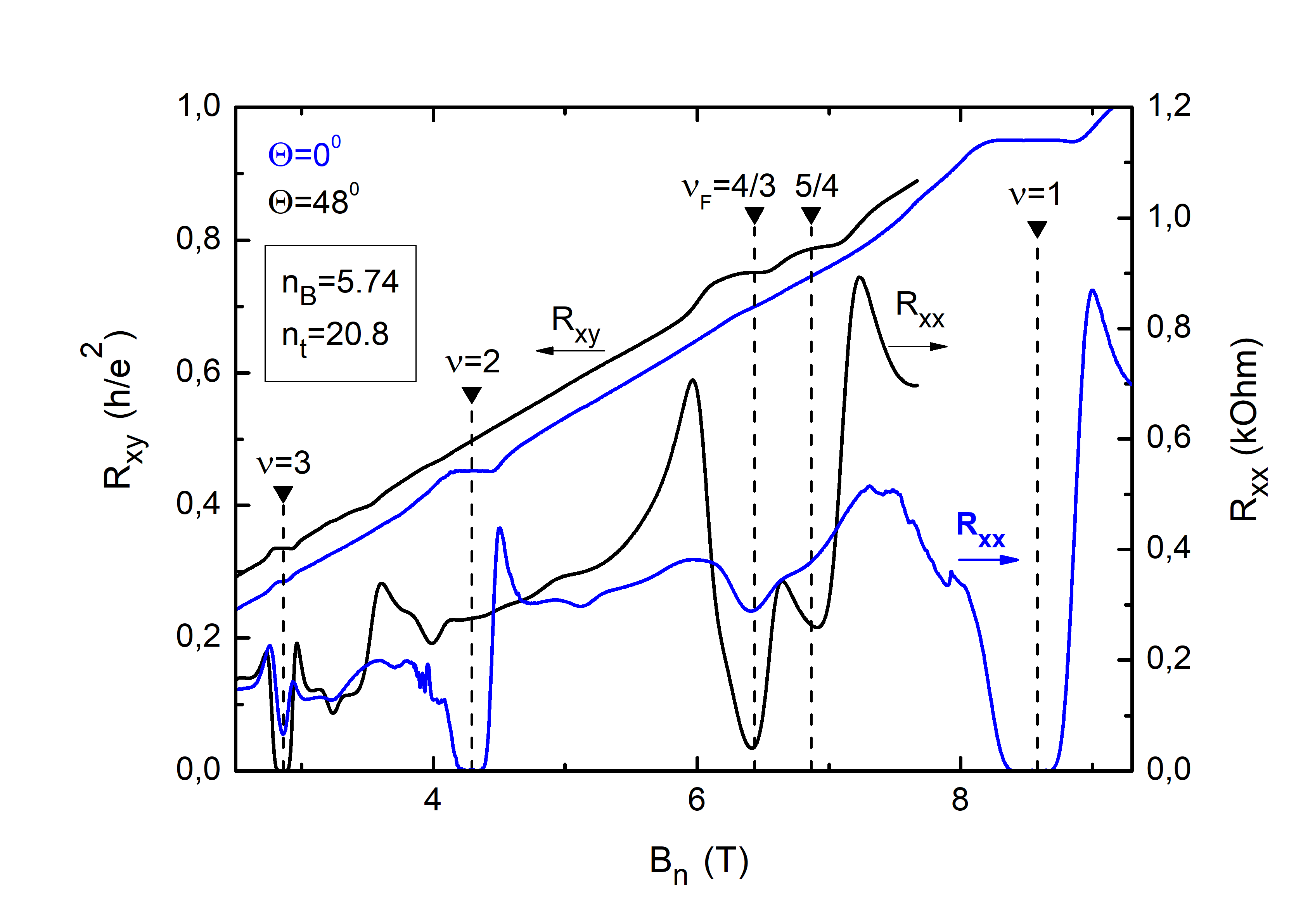
The magnetoresistance $R_{xx}$ (right scale) and Hall resistance $R_{xy}$ (left scale) versus normal component $B_n$ of magnetic field for two angles between the field and normal to the quantum well: $\Theta=0^{\circ}$ (blue lines) and $\Theta=48^{\circ}$ (black solid lines). Blue $R_{xy}$ line is shifted downwards by 0.05 for clarity. Vertical dashed lines show positions of total filling factors $\nu$ and $\nu_F$. The electron densities in the lower density layer $n_B$ (measured at low magnetic field) and in total electron system $n_t$ are given in units of $10^{10}$~cm$^{-2}$. Temperature $T=0.5$~K.
[1] S.I. Dorozhkin, A.A. Kapustin, I.B. Fedorov, V. Umansky, K. von Klitzing, and J.H. Smet, J. Appl. Phys. 123, 084301 (2018).
[2] S.I. Dorozhkin, A.A. Kapustin, I.B. Fedorov, V. Umansky, and J.H. Smet, Phys. Rev. B 102, 235307 (2020).
S. I. Dorozhkin, A. A. Kapustin, and I. B. Fedorov, V. Umansky, J.H. Smet
JETP Letters 117, issue 1 (2023)
The Figure below shows the Fermi surfaces for InCo2As2 (panel (a)) and KInCo4As4 (panel (b)) obtained in LDA. For InCo2As2, all large sheets of the Fermi surface are concentrated around the corners of the Brillouin zone. For InCo2As2, all Fermi surface sheets have a pronounced kz-dependence. In the KInCo4As4 system, where the K- and In- layers of the crystal structure are interchanged, the Fermi surface becomes practically quasi-two-dimensional (panel (b)). It can also be seen in the band structure in the G-M and M-A directions near the Fermi level are almost identical (Panel (b)) in contrast to InCo2As2 (panel (а)). The Fermi surface for KInCo4As4 is similar to that of iron-containing superconductors, but the shape of the Fermi surface sheets near the G-point is closer to a rectangular prism than to a cylinder. This shape of the Fermi surface sheets may facilitate nesting. Experimental synthesis and study of the KInCo4As4 samples is interesting for testing the occurence of superconductivity.
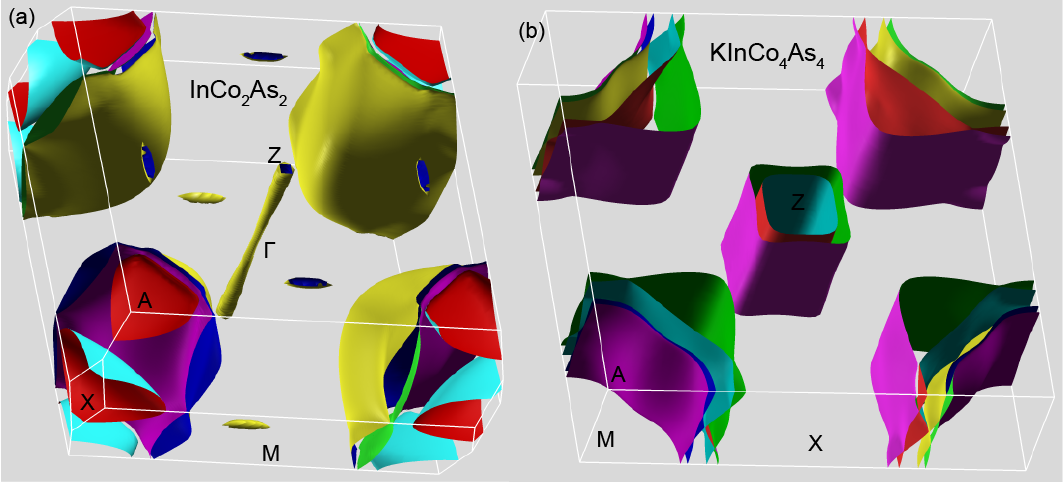
DFT/LDA calculated Fermi surfaces for InCo2As2 (panel (a)) and KInCo4As4 (panel (b)).
N.Pavlov, I.Shein, K.Pervakov, I.Nekrasov
JETP Letters 117, issue 1 (2023)
One of the most important directions in modern methods of micro-fabrication is stereographic two-photon polymerization lithography (TPP). This method enables creating three-dimensional polymer structures with a high accuracy, and is also very flexible for any production tasks.
Here we show how the TPP method can be useful for printing the basic elements of three-dimensional integrated optics. We fabricated polymer waveguides with attached prism adapters, as well as microresonators of various shapes and sizes. The waveguides suspended above a glass substrate with input/output prisms (Fig.1(a)) showed good efficiency in low-mode regime. The advantages of the proposed prism coupler are small size, wide spectral range and low losses (no more than 1.25dB). Another important feature of this work is the demonstration of printing of an active optical system using a polymer doped with various laser dyes. We also demonstrate combined systems consisting of active microresonators and passive waveguides on a single substrate (Fig.(c)). The future development of such integrated optical system is very promising for creation of three-dimensional optical logic and sensor devices.
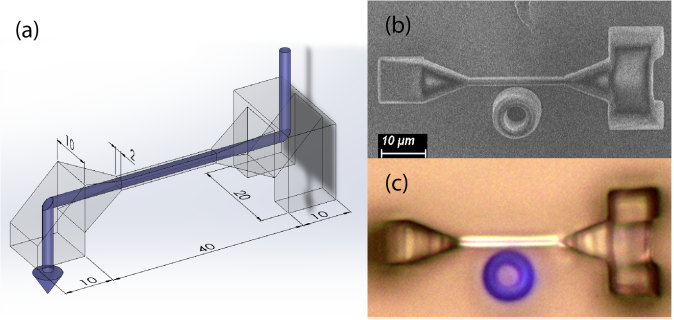
Figure 1. a) 3D model of a suspended waveguide with prism adapters, the blue line shows path of the optical beam, b) SEM image of the printed structure, c) optical image of the printed structure under illumination with white light and UV radiation, the blue ring is the luminescence of the dye in the cylinder.
A.Maydykovskiy, D.Apostolov, E.Mamonov, D.Kopylov, S.Dagesyan, T.Murzina
JETP Letters 117, issue 1 (2023)